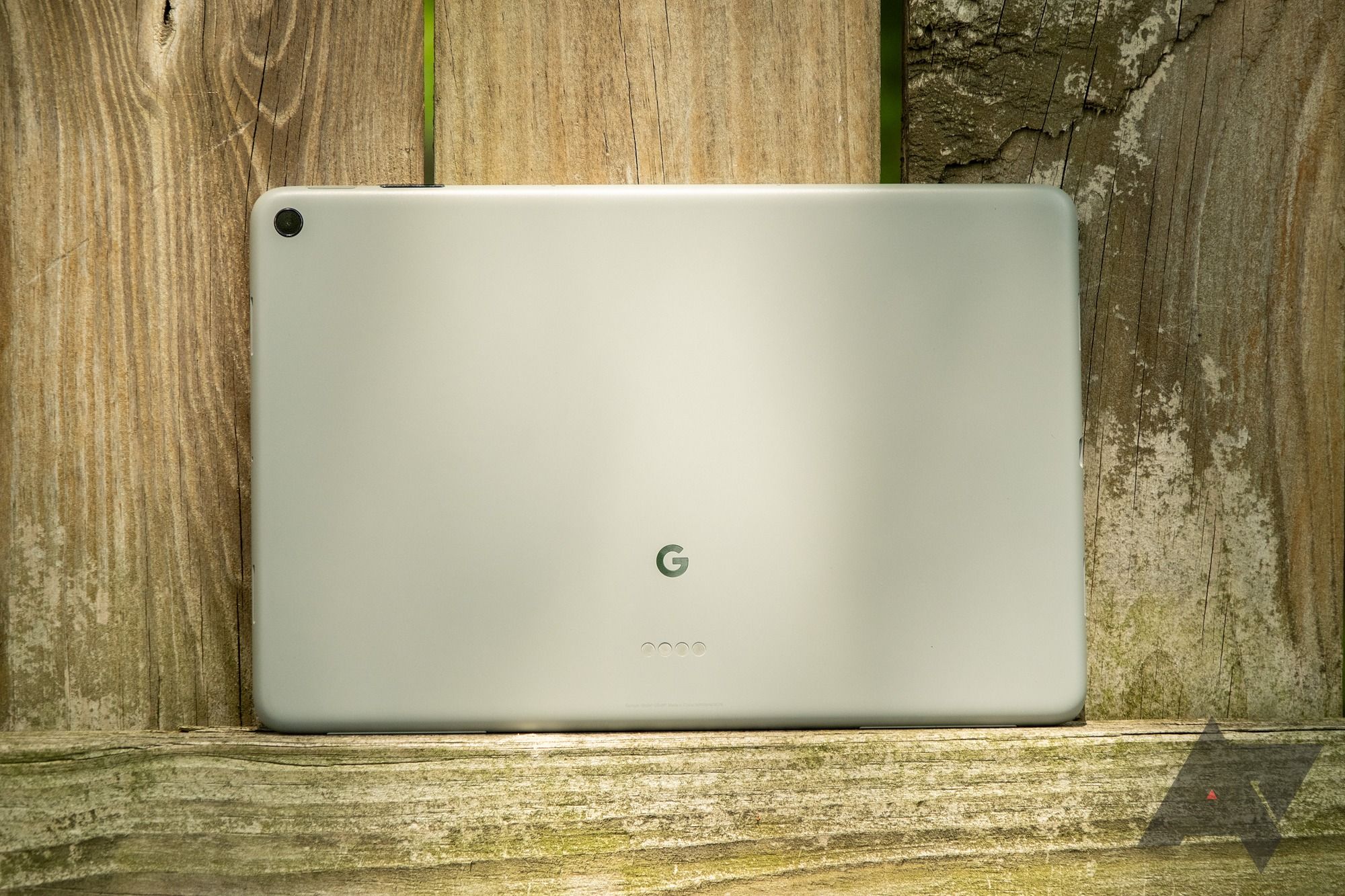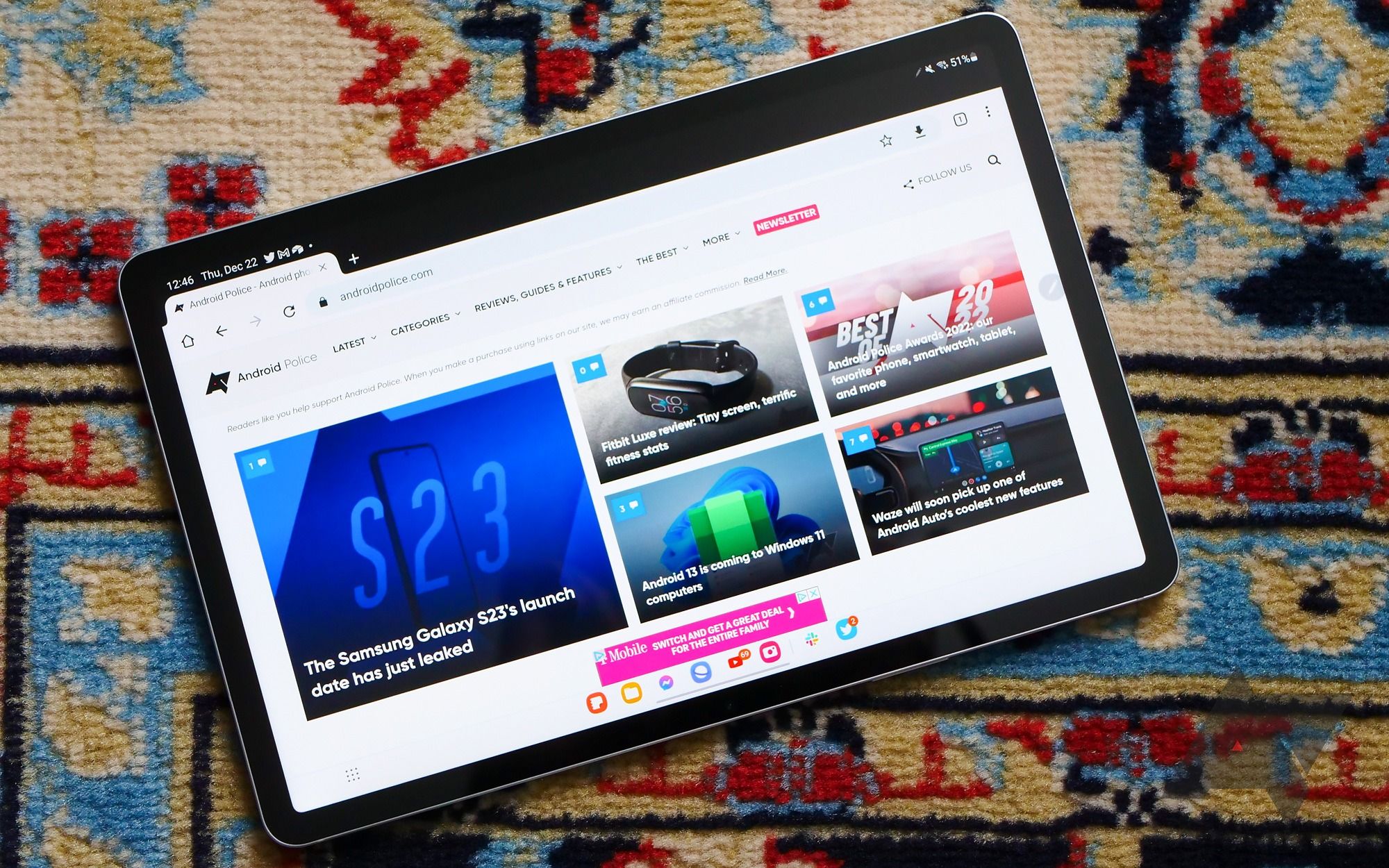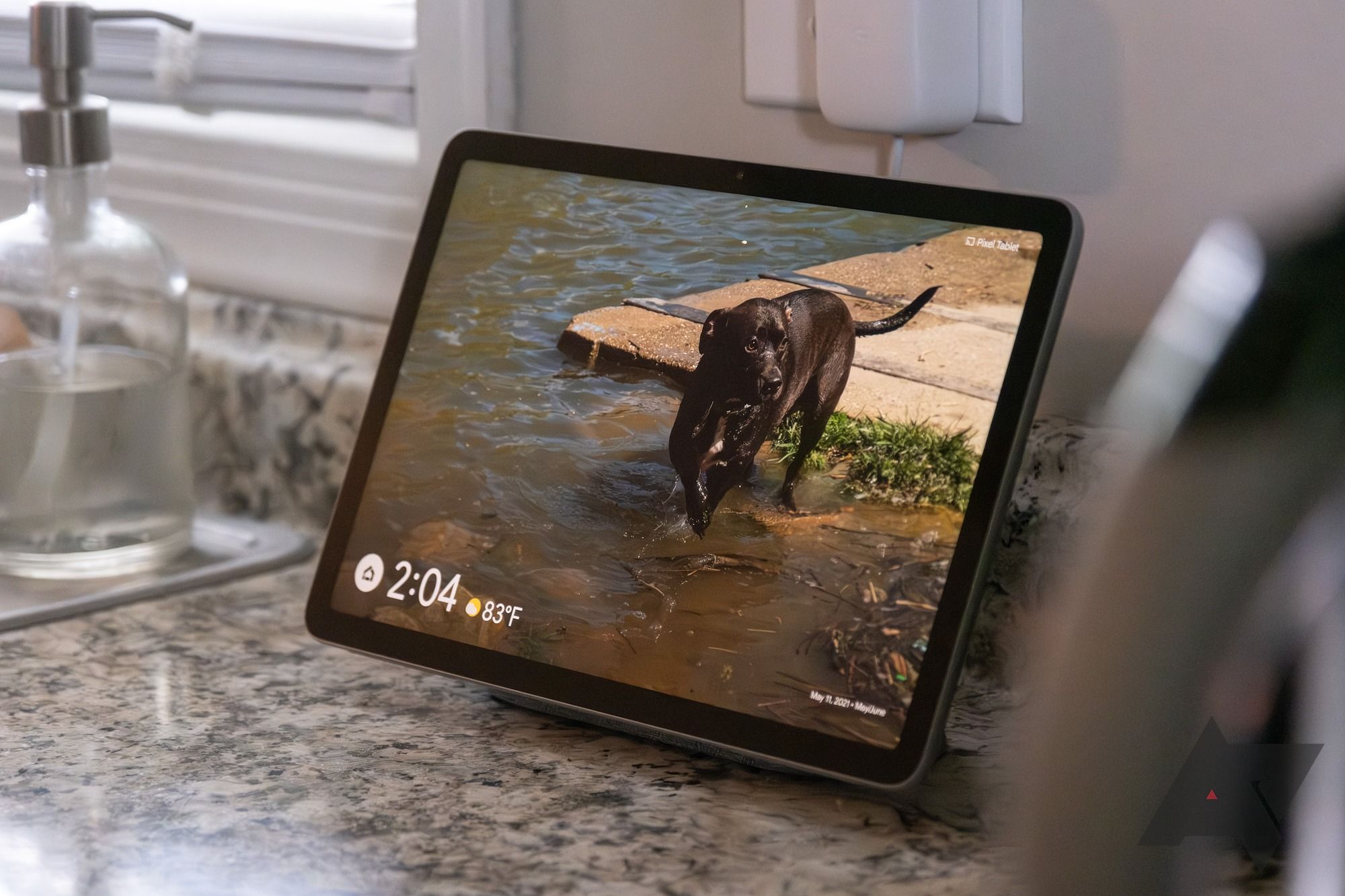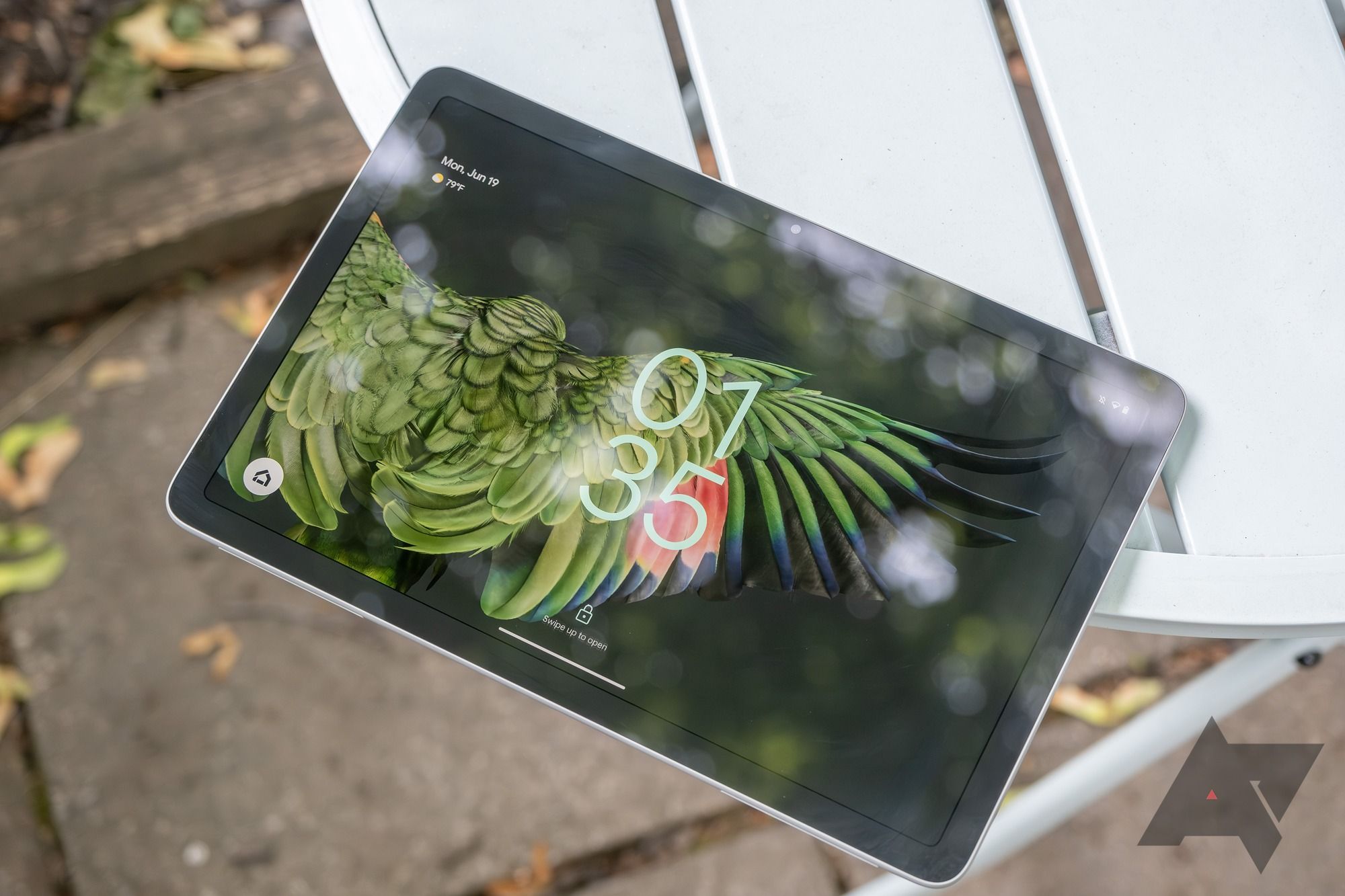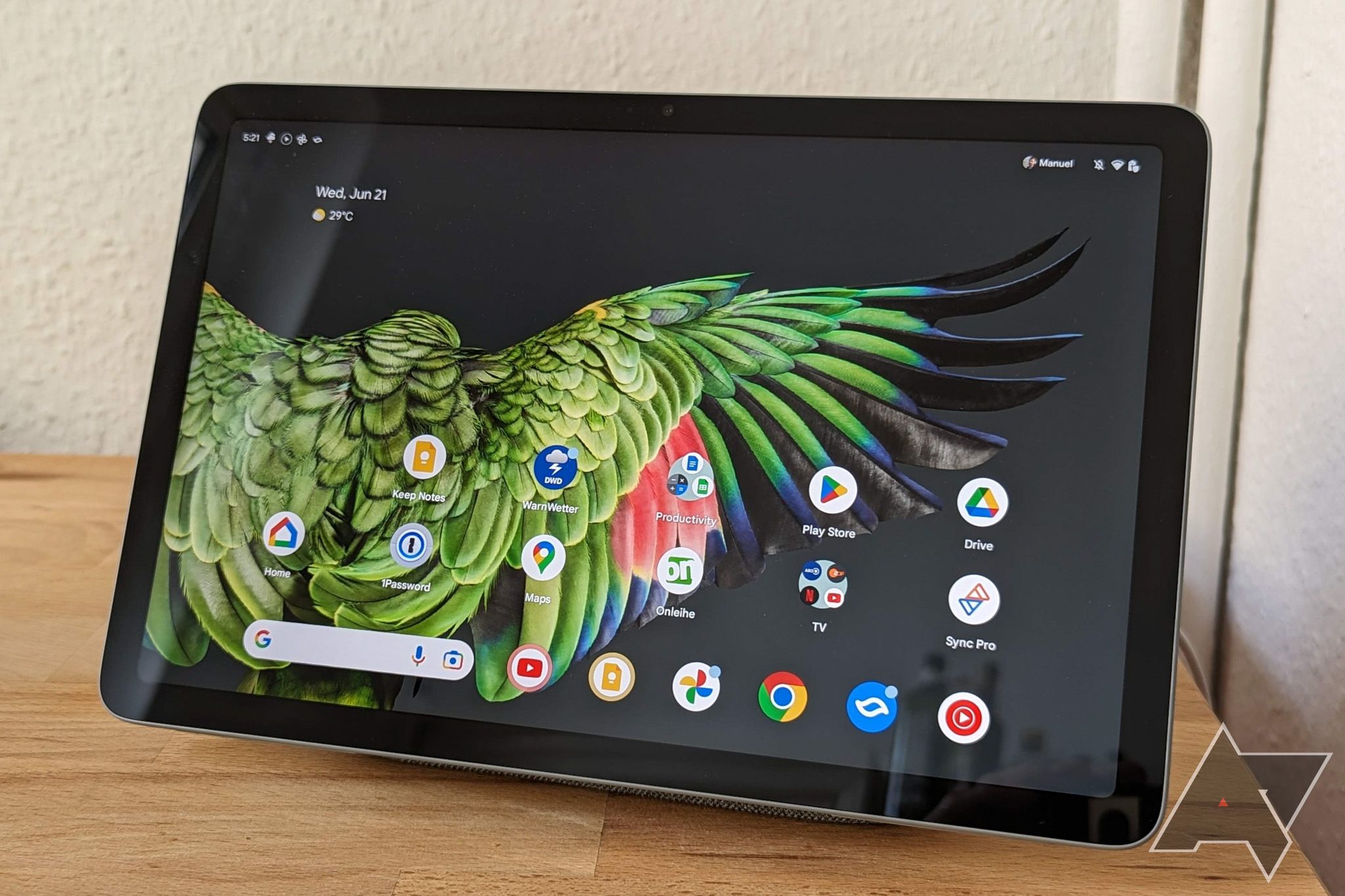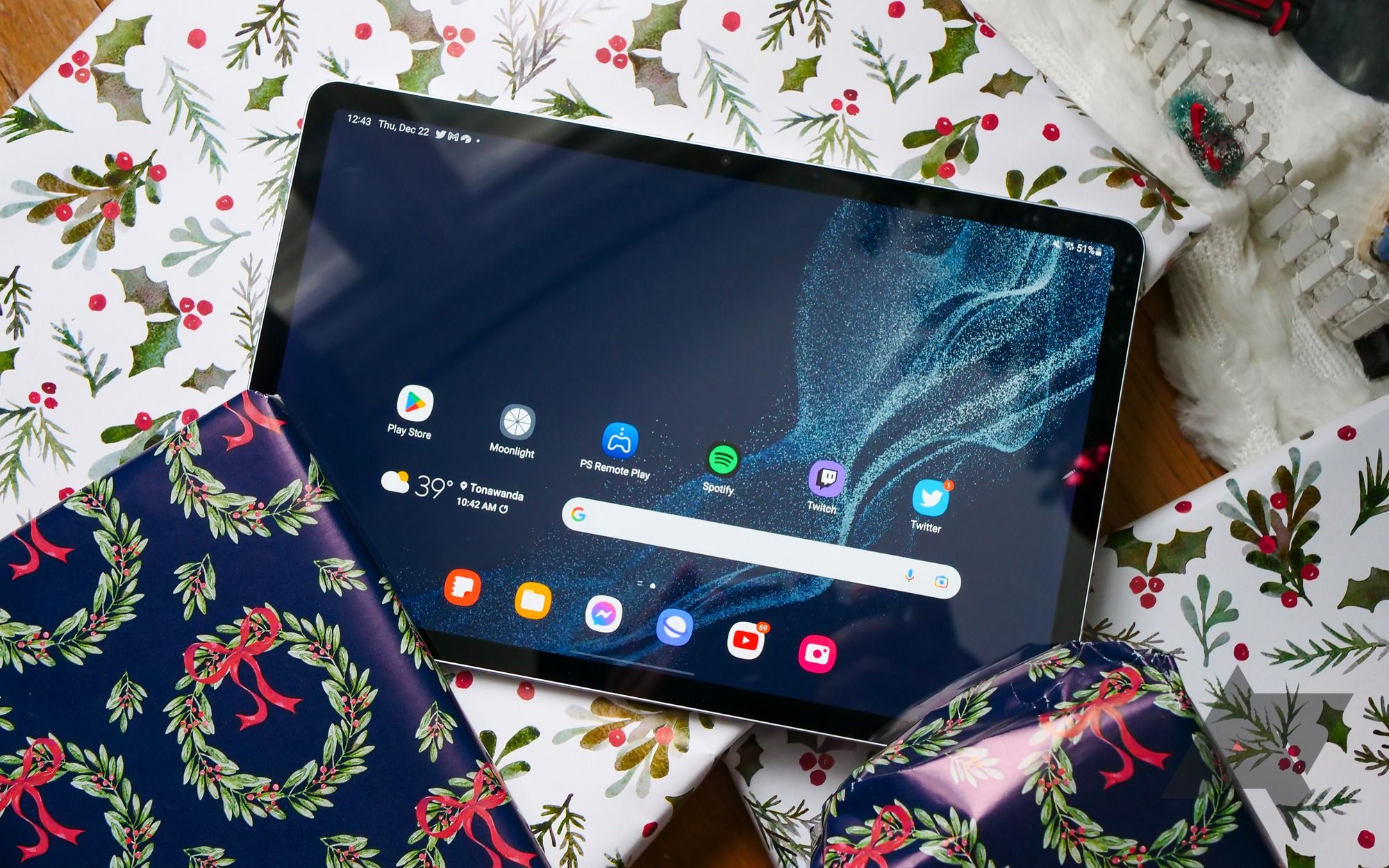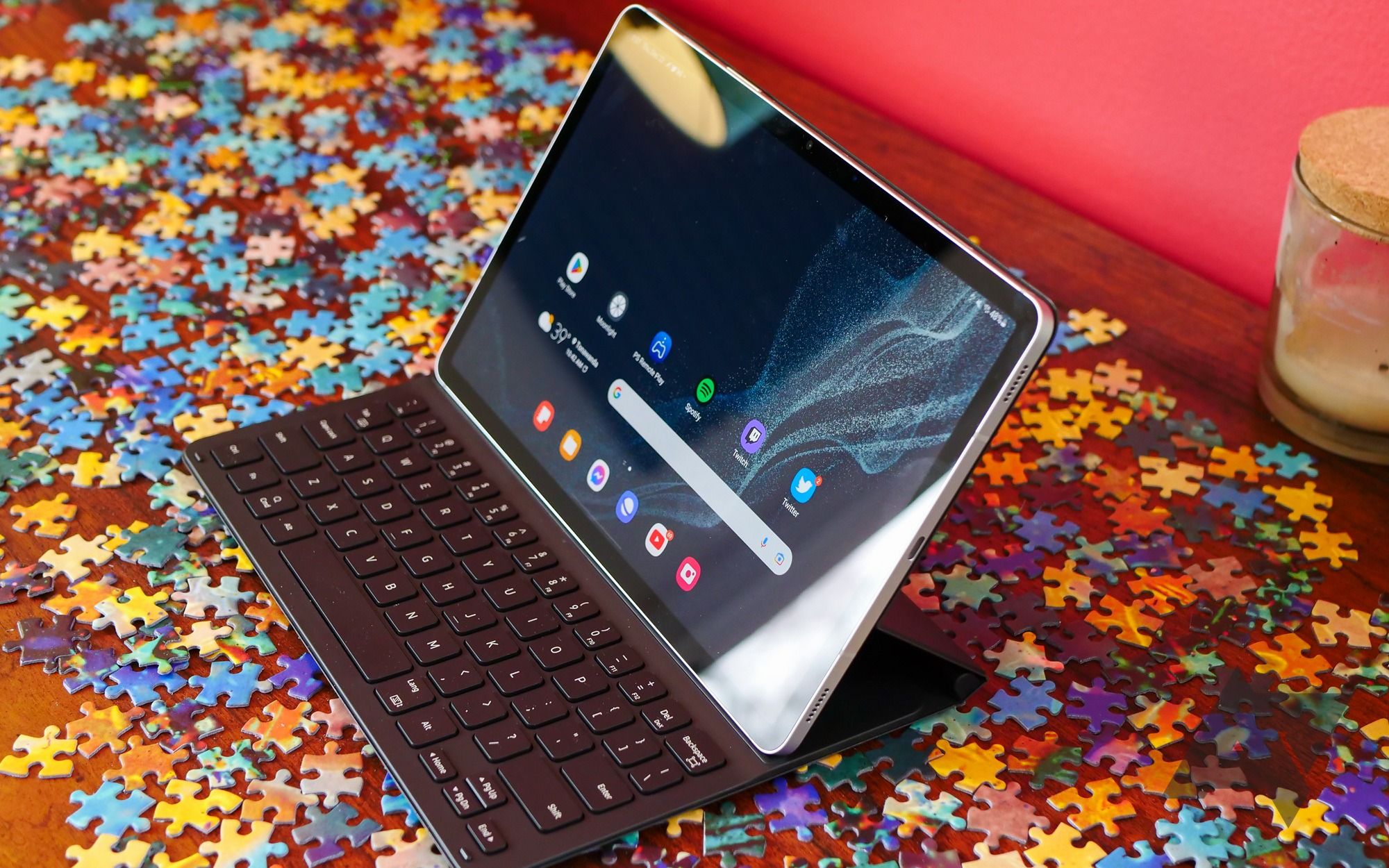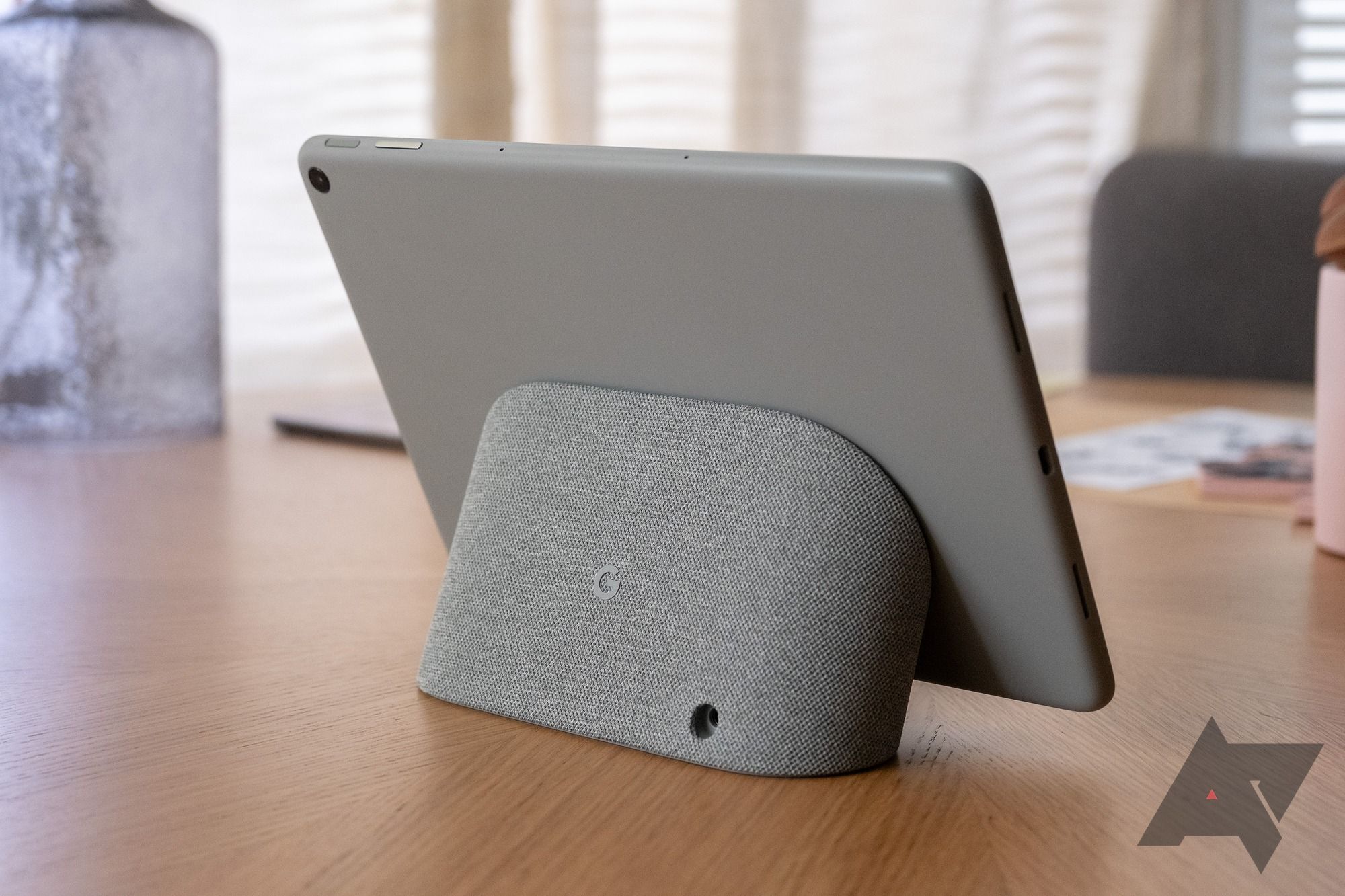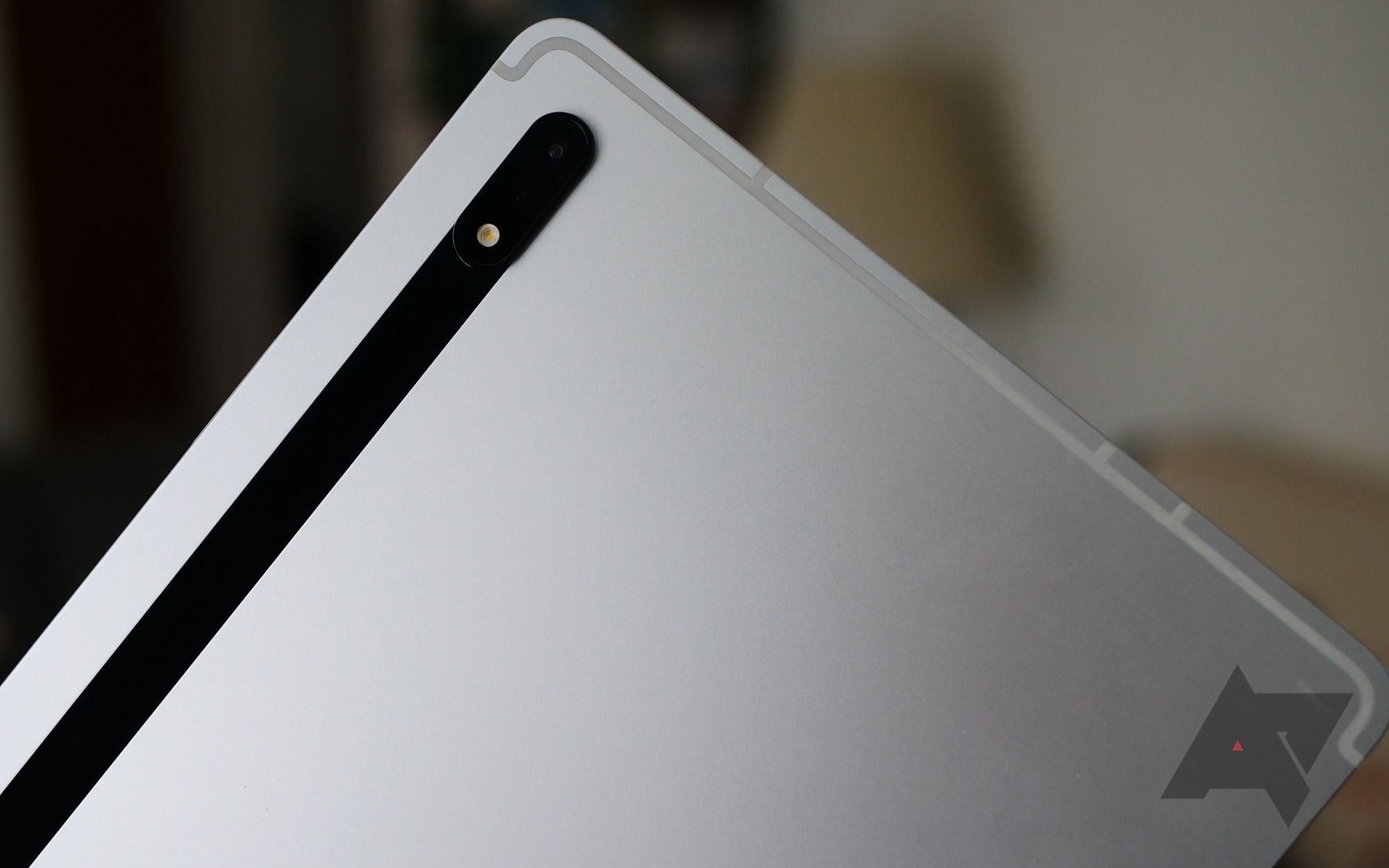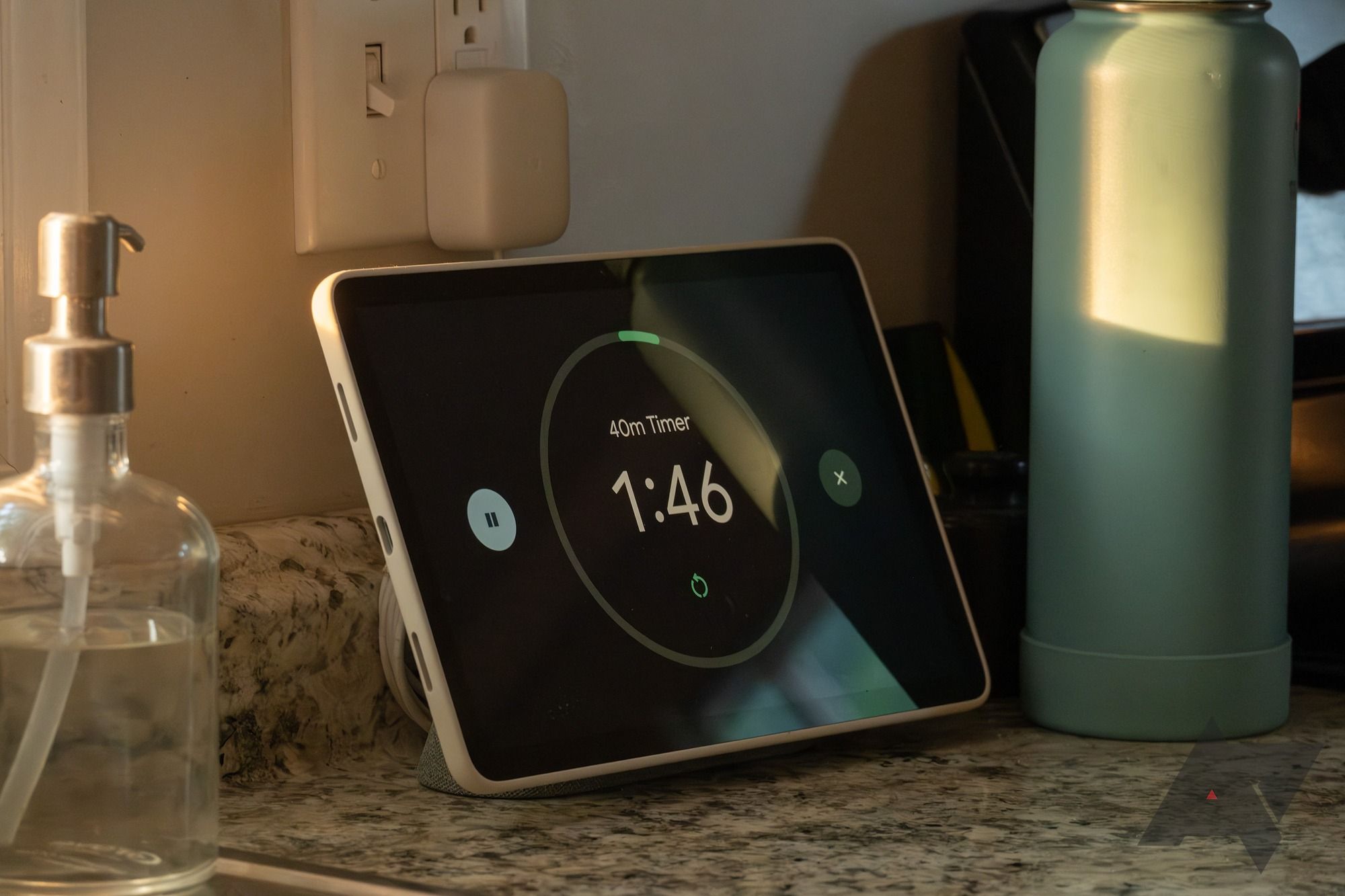-
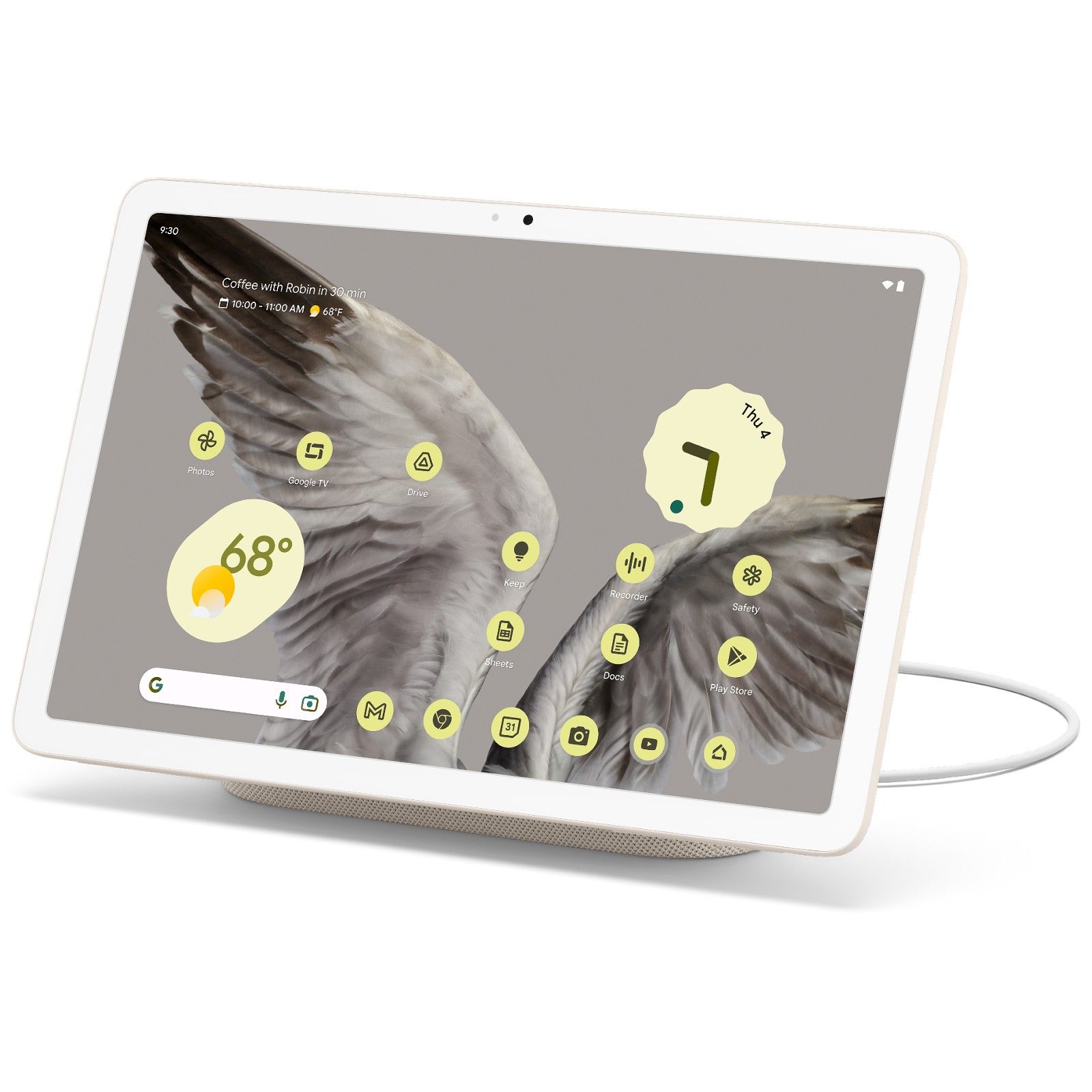
Google Pixel Tablet
Smart home hub
Google’s Pixel Tablet offers a comfortable design intended to blend into your hand and your home, with an included Charging and Speaker Dock that lets it become a centerpiece of your living space. Powered by Google’s Tensor G2, it offers plenty of power for gaming and streaming, plus a unique Hub Mode that turns it into a smart display when docked.
Pros- Packs in Google’s powerful Tensor G2
- Includes Charging Speaker Dock
- Offers built-in Hub Mode for use as a smart display
Cons- Average LCD display
- No stylus included
-
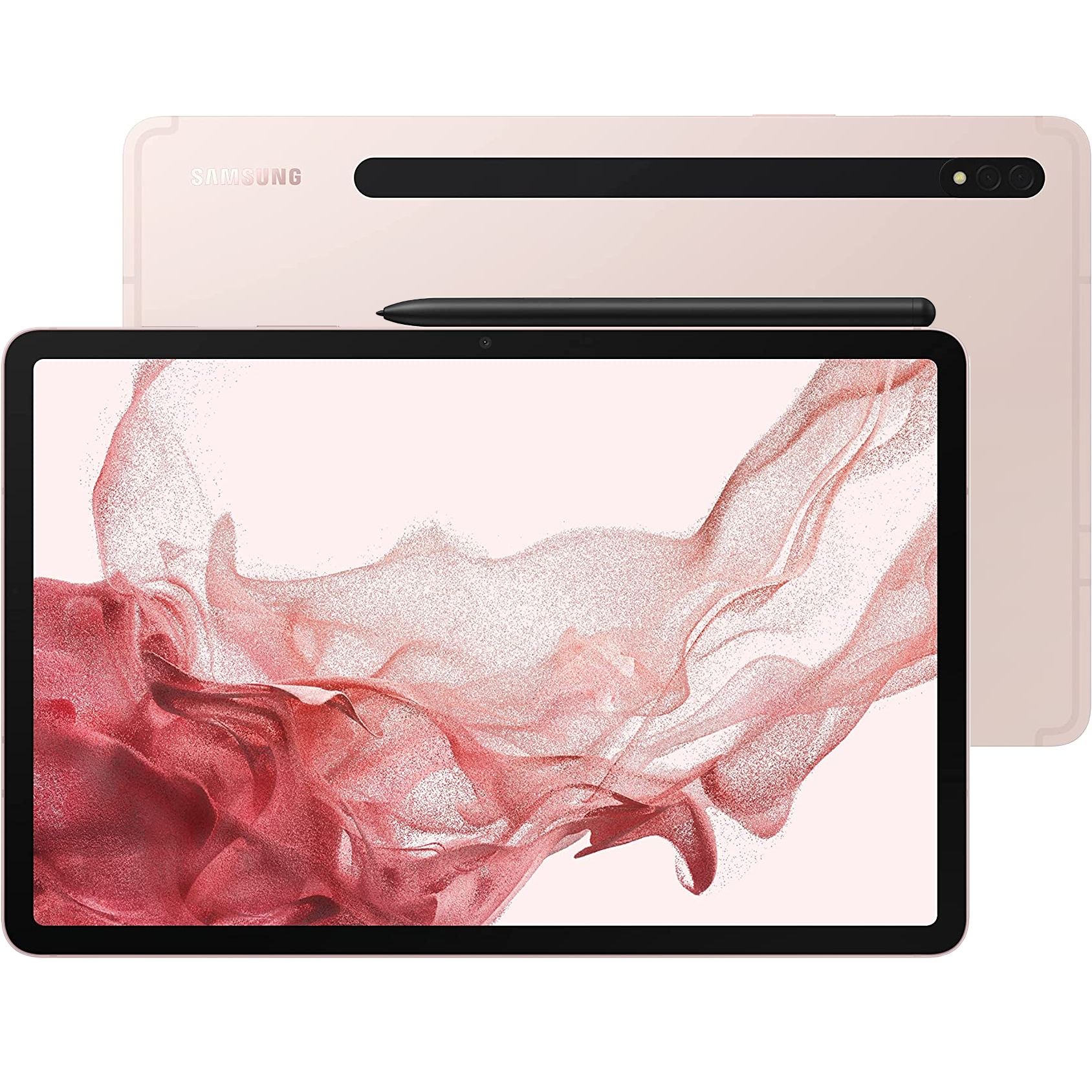
Samsung Galaxy Tab S8
Former flagship
$595 $700 Save $105
The Samsung Galaxy Tab S8 features a premium design, a 120Hz display, an S Pen stylus, a powerful Snapdragon 8 Gen 1 chipset, and enough RAM to handle any task you’re likely to need from a tablet. It may be over a year old, but this is still one of the best Android tablets you can buy.
Pros- Small enough to easily hold in your hands
- S Pen included in the box
- Excellent performance and battery life
Cons- Smaller screen hampers productivity tools
- The S Pen can feel like it’s dragging across the glass
- Lacks an AMOLED panel
The Google Pixel Tablet is the first Android-powered tablet out of Mountain View since the 2015 Pixel C. Although Google made an interim attempt at rolling out a tablet in 2018 with the Chrome OS-powered Pixel Slate, the Pixel Tablet integrates much better with Google’s hardware ecosystem. It isn’t perfect, but it’s still one of our favorite Android tablets.
Google may have sponsored early Nexus tablets, but Asus, Samsung, and HTC built them. After Google shelved its branded tablets to focus on Chromebooks, companies behind their manufacturing easily made up for Google’s temporary cessation of tablet production. For example, for over a decade, Samsung has consistently released new Galaxy Tab S series tablets. The 2022 Galaxy Tab S8, launched a year earlier than the Pixel Tablet, is a close contender to Google’s Pixel Tablet.
So how does Google’s reentry into the world of Android tablets shape up against Samsung’s Galaxy Tab S8 series? Let’s find out.
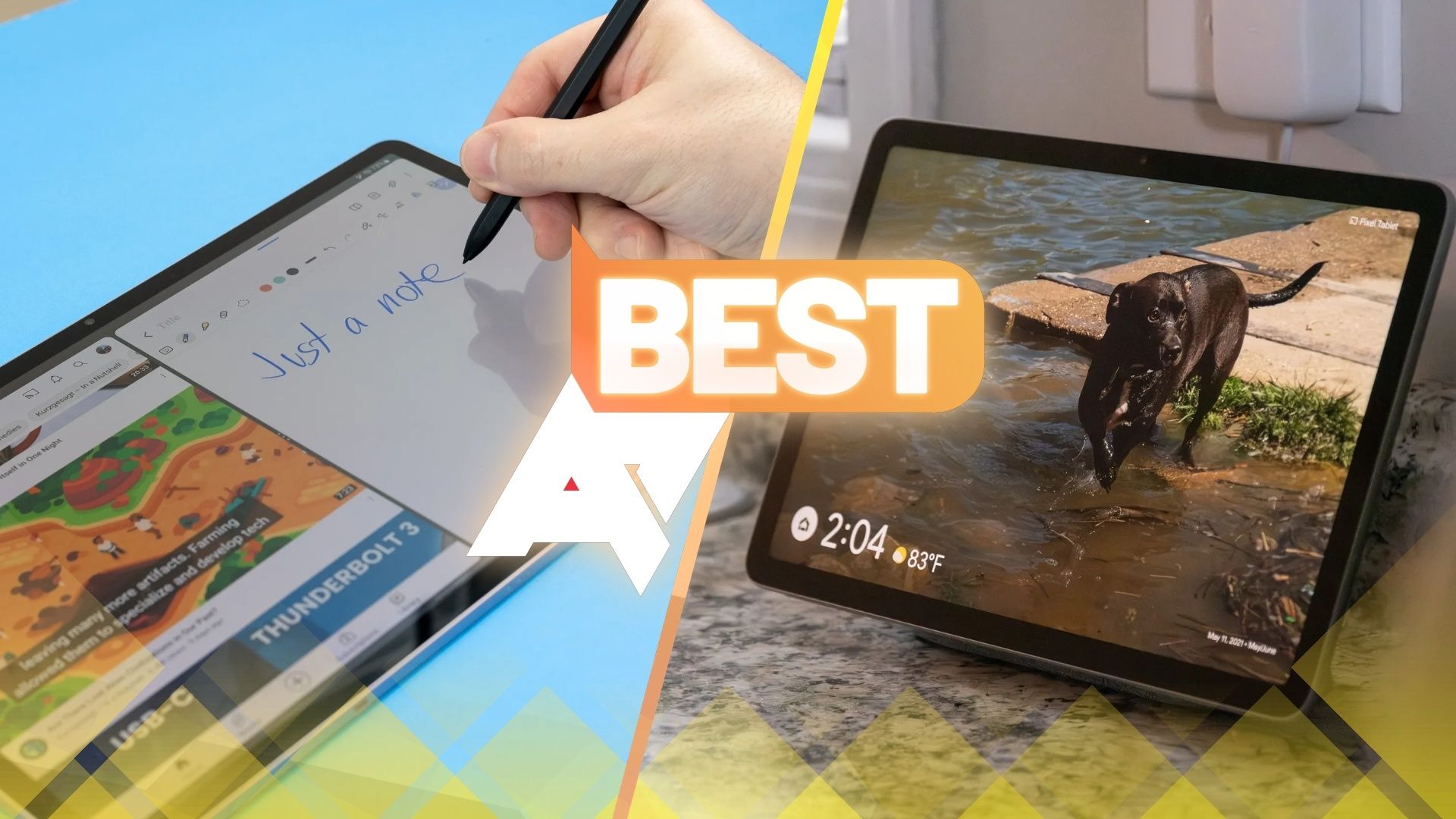
Best Android tablets in 2024
Android tablets are for anyone; here are our favorites
Price, availability, and specs
Google’s Pixel Tablet is available from the Google Store and other retailers, starting at $499 for the base 128GB model with 8GB RAM. It’s available in Porcelain, Hazel, and Rose finishes and includes a color-matched Charging and Speaker Dock in the box. A 256GB version is also available for anyone requiring a beefier storage function.
Samsung’s Galaxy Tab S8 launched in 2022 at a starting price of $700 for the similarly-equipped 128GB model. It’s available at Samsung and most other major retailers like Amazon and Best Buy. It can often be found for considerably less than its regular asking price, especially now that the Tab S9 range has hit the market. Your color choices for the Tab S8 are Graphite, Silver, and Pink Gold.
-
Google Pixel Tablet Samsung Galaxy Tab S8 Storage 128GB or 256GB 128GB or 256GB Operating System Android 14 Android 14 and One UI 6 Battery 7,020mAh 8,000mAh Price From $500 From $700 Ports USB-C USB-C Display type IPS LCD, 60Hz LCD, 120Hz Colors Porcelain, Hazel, Rose Graphite, Pink Gold Display dimensions 10.95″, 16:10 11″ Display resolution 2560 x 1600 1600 x 2560 Weight 493g 503g SIM support No No SoC Google Tensor G2 Snapdragon 8 Gen 1 Cellular connectivity No No Wi-Fi connectivity Wi-Fi 6 Wi-Fi 6E Bluetooth Bluetooth 5.2 Bluetooth 5.2 Stylus No Yes RAM 8GB 8GB Front Camera 8MP, f2/0 12MP Rear Camera 8MP, f2/0 13MP main; 6MP ultrawide Dimensions 258 x 169 x 8.1mm 165.3 x 253.8 x 6.3mm Charging speed 15W wired 45W wired
Design
The Google Pixel Tablet features a contoured design that will feel familiar to anybody who has ever held an older model of the iPad. It’s comfortable in the hand and easy to get working on as a result. Rather than going with the more squared-off corners of its kin, the Pixel Tablet goes with rounded corners, a bold choice to break away from the typical design language, but one that certainly pays off.
It takes it a step further, surpassing Apple’s similarly rounded designs by featuring a nano-ceramic coating and a soft matte look that’s easier on both the eyes and the hands than the more spartan metallic backing of an iPad. This gives it a textured, porcelain-like feel, which undoubtedly inspired Google’s choice to use “Porcelain” as its standard color. However, the Pixel Tablet is also available in Hazel and Rose.
While Samsung’s Galaxy Tab S8 measures roughly the same size as the Pixel Tablet, it’s an entirely different species when considering the design of these two competitors. As we noted in our review, the squared-off edges make it feel like a clone of Apple’s iPad Pro; if it weren’t for the difference in aspect ratios, it would be hard to tell the two devices apart. While that’s a popular design (since Apple has stuck with it for years), it won’t fit everyone’s style preferences.
If you are a dedicated stylus user while working on your tablet, the Galaxy Tab S8 handily takes the edge here. It not only includes Samsung’s S Pen in the box, but it also carves out a space on the back of the tablet to magnetically dock it, adding charging to this cutout. It’s not the most convenient location, but at least it’s there. Although the Pixel Tablet is compatible with USI 2.0 styluses, it doesn’t come with one included or offer any special docking or charging capabilities. If you want to travel with a stylus, you’ll have to add a case, which is a shame for those who like the natural aesthetic since the Pixel Tablet looks so good without one.
While you won’t get a stylus, Pixel Tablet buyers open the box to find something else, perhaps even better. The Pixel Tablet comes with a Charging Speaker Dock that provides a dedicated place to drop your tablet when you want to charge it and prop it up as a smart display. The integrated speakers are perfect for use as a video calling platform or music hub while working in the kitchen or getting ready for the day.
The first one is included, but you can purchase additional speaker docks to strategically place a few around your home. This will allow you to connect your Pixel Tablet in any room that may want to use the device as a media and home hub. It also includes a built-in, polished metal ring stand, so you can prop it up at nearly any angle without adding additional accessories.
Display
If there was a single disappointment with the release of the Samsung Galaxy Tab S8, it was the lack of an AMOLED screen. In an effort to keep its entry-level tablet as affordable as possible, Samsung went with an 11-inch LPTS LCD, setting the S8 apart from the premium versions that feature in the lineup.
Considering the Tab S8 launched with a $700 price tag and the Pixel Tablet starts at $500, it’s probably no surprise that Google cut the same corner in display technology. The Pixel Tablet also features a 10.95-inch LCD. While it’s undoubtedly a display that provides a good quality picture, the screen is nothing to write home about. The Galaxy Tab S8 and Pixel Tablet are roughly on par when it comes to display technology; both use the same 16:10 laptop-style aspect ratio, 2560 x 1600 resolution, and around 500 nits of brightness, although the Tab S8 enjoys a slight edge for its faster 120Hz refresh rate.
Google is positioning the Pixel Tablet as a device targeted primarily for media consumption. It’s a workhorse for activities like streaming movies, running games, and showing off your photos. That’s where we felt the Galaxy Tab S8 landed as well, despite Samsung’s efforts to promote it as a more well-rounded device.
Software
Samsung’s Galaxy Tab S8 launched with the Android 12 system under its hood. This was the current version then, but it was already ahead of the curve thanks to Samsung’s tablet-friendly One UI Android skin. Until the introduction of Android 12L, the Android system was a clunky, awkward experience on most other tablets. Therefore, Samsung came up with its solution for a tablet-friendly OS.
That’s less of an issue now since these capabilities have been folded into Android 14, the OS version both tablets now run.
Samsung promises four years of updates for the Galaxy Tab S8, meaning it should support updates through to Android 16. Google is promising a similar update cycle that will take it one version beyond that, into Android 17. Google also promises at least five years of security updates, providing a lengthy coverage of security updates for your device and its stored data. Whether you’ll still be hanging on to your Pixel Tablet in 2028 is another question, but it’s nice to know you have the option.
Regarding software features, both tablets offer a slate of features that align with typical expectations from each company. Samsung layers its One UI on top of the Android 13 system, while the Pixel Tablet provides the usual “pure Google” experience. Naturally, it also integrates seamlessly with the rest of your Pixel devices.
Google has another trick up its sleeve for the Pixel Tablet, though. In addition to everything you’d expect from a Pixel-optimized version of Android, the Pixel Tablet is also designed to double as a home hub and smart display. When utilizing the included Charging Speaker Dock, the tablet automatically switches its function to introduce its Hub Mode. This lets you use the device as a digital photo frame, and you can control your Google Home accessories, view cameras, and call up Google Assistant from anywhere in the room via this augmented Pixel Tablet mode.
Performance
The Galaxy Tab S8 and Pixel Tablet pack the same processors as their contemporary smartphone cousins. However, since the Galaxy Tab S8 is a year old, it utilizes the Snapdragon 8 Gen 1 platform in Samsung’s Galaxy S22 lineup. This is an impressive chip for an Android tablet from 2022.
The same custom Tensor G2 debuted in the Pixel 7 and Pixel 7 Pro is included in the Pixel Tablet. On paper, you might think that gives the Pixel Tablet an edge in performance, but in reality, both tablets will likely remain pretty evenly matched — especially if you intend to use the device for light streaming, music, and other typical tablet demands.
In raw performance, Google’s Tensor G2 doesn’t beat the Snapdragon 8 Gen 1 in most benchmarks. Most of its advantages come from the machine learning capabilities that Google has baked into it, which power Google’s advanced computational photography features on its Pixel phones. There’s less demand for that capability on a tablet, and while we’ll have to wait for some real-world tests, the Galaxy Tab S8 and Pixel Tablet likely offer similar gaming and streaming performance. This makes them fairly evenly matched in the processing department.
Battery life
Google promises up to 12 hours of 1080p streaming for YouTube video on a single charge. This suggests that most typical users may only need to plug the device in every two or three days. That’s likely to come out to a similar timeline alongside the Galaxy Tab S8, which we noted in our review offered “excellent battery life with mixed usage.”
Of course, your experience will undoubtedly vary depending on how you use either tablet. Hardcore gamers or those who treat it as their primary viewing device for streaming movies and TV shows will almost assuredly need to plug the tablet in every night, regardless of the selection. However, the Pixel Tablet has a notable advantage here thanks to its included Charging and Speaker Dock. Not only does the included dock make it easier to charge, but you’re more likely to insert the Pixel Tablet into the dock to turn it into a home hub when you’re not otherwise using it. This gives you at-the-ready hub functionality and a passive charging effort that doesn’t require you to remember to plug it in. However, the Pixel Tablet can also be charged using a standard USB-C adapter, although you’ll have to buy that separately.
Cameras
Rear-facing cameras on tablets often feel like something manufacturers include simply because they feel they have to in keeping with typical design trends. While you’ll always see a handful of folks holding up their tablets to take pictures at concerts and other events, it’s a rarity that doesn’t often factor into the buying calculus for these larger-screened devices.
Samsung and Google seem to understand this, and the rear cameras on the Galaxy Tab S8 and Pixel Tablet are competent for things like scanning documents but don’t otherwise stand out in any meaningful way. The Galaxy Tab S8 offers a dual-rear camera array that combines a 13-megapixel (MP) standard lens with a 6MP ultra-wide offering. That’s pretty impressive for a tablet, but it still pales compared to what’s found on even Samsung’s entry-level Galaxy A03. On the other hand, Google isn’t even putting the Pixel Tablet in the race; its rear camera is built with a pedestrian, single 8MP fixed focus lens.
Around the front, the Galaxy Tab S8 offers a 12MP ultra-wide camera that’s at least on par with, if not better, than what you’ll find on many laptops. Unfortunately, the Pixel Tablet’s front camera is the same as its rear one, with only an 8MP resolution and a fixed focus. However, both tablets offer auto-framing technology similar to the Center Stage feature found on Apple’s iPads without the branded name and the awkward short-edge camera placement. The Galaxy Tab S8 and Pixel Tablet put the camera on the longer side, making much more sense for video calls. The Galaxy Tab S8 takes pole position here, but your interest in the camera’s technology and specs will depend heavily on whether you intend to use the feature.
Which is right for you?
Google’s Pixel Tablet offers impressive specs and innovative features that set it apart from the competition. While it doesn’t necessarily offer more raw power, Google’s Tensor G2 is a newer chip that opens the door to more possibilities thanks to its focus on AI and machine learning capabilities. All that power, combined with four years of software updates and five years of security patches, means you could still enjoy this tablet in 2028.
The Pixel Tablet is also designed with specific applications and functionality in mind. This allows for a razor-sharp focus on doing those things exceedingly well. Rather than trying to be all things to all people, this is a tablet that knows its purpose in life and doesn’t try to be something it isn’t, creating a lesser user experience in the process. The Pixel Tablet is a content consumer, allowing for a rich enjoyment of media and gaming content while also anchoring your smart home.
There’s no stylus included, further driving home the point that this is an entertainment tool rather than one focused on productivity. Instead, Google has packed a dock in the box that turns the Pixel Tablet into a central hub for your home, with the ability to show off your favorite memories, play music through its built-in speaker, quickly control accessories, and see what’s going on outside, as well as the integrated ability to call up Google Assistant from anywhere in the room.
On top of all that, Google is offering the Pixel Tablet at a starting price of $500 with the Charging Speaker Dock included. That’s a considerable bargain, especially when it provides most of the same capabilities as Samsung’s Galaxy Tab S8, typically at least $100 more even when it’s on sale.

Google Pixel Tablet
Best overall
Google’s Pixel Tablet offers a comfortable design intended to blend into your hand and your home, with an included Charging and Speaker Dock that lets it become a centerpiece of your living space. Powered by Google’s Tensor G2, it offers plenty of power for gaming and streaming, plus a unique Hub Mode that turns it into a smart display when docked.
Of course, the design of the Pixel Tablet isn’t for everyone, and if you’re looking for an option that offers just a few more productivity-focused features, then Samsung’s Galaxy Tab S8 is still a solid pick. This is especially true if you can find it on sale. For one, you’ll get the S Pen in the box, plus a place to dock it and charge it when you’re not actively using the accessory. Plus, if you’re already invested in the Samsung ecosystem, the Galaxy Tab S8 may be a more natural fit alongside your Galaxy S series smartphone and Galaxy Buds Pro.

Samsung Galaxy Tab S8
Good alternative
$595 $700 Save $105
The Samsung Galaxy Tab S8 features a premium design, a 120Hz display, an S Pen stylus, a powerful Snapdragon 8 Gen 1 chipset, and enough RAM to handle any task you’re likely to need from a tablet. If you’re happy with the 11-inch display, this is one of the best Android tablets you can buy.
Source link
